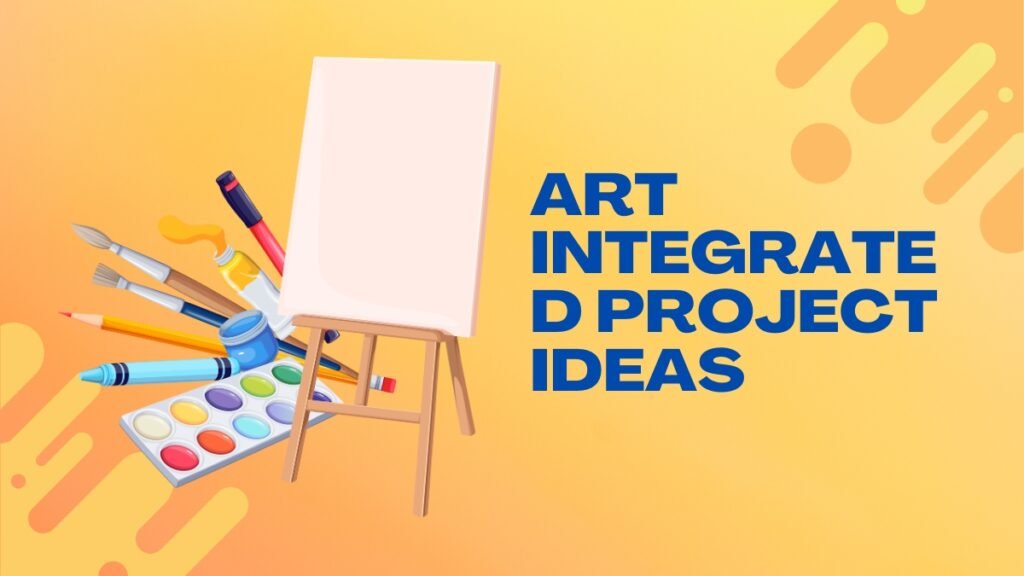Explore creative art integrated project ideas that blend artistic expression with subjects like science, history, literature, and math. Discover how to bring learning to life through imaginative and engaging artistic endeavors.
Ever looked at a scientific equation and thought, “That would make a great abstract painting!” Or imagined stepping into a historical event to create art inspired by it?
Well, you can! This guide explores fun art projects that mix creativity with subjects like science, history, literature, and math. Get ready to spark your imagination and discover how art can bring different subjects to life in exciting new ways!
Art Integrated Project Ideas PDF
Importance of Incorporating Art into Various Subjects
In today’s world of textbooks and tests, adding art to lessons brings big benefits for students:
- Boosts Creativity and Problem-Solving: Art helps kids think in new ways and find clever solutions.
- Enhances Learning and Memory: Drawing and creating help students understand tough ideas and remember them better.
- Improves Communication: Art lets students share feelings and ideas in cool ways like drawing and acting.
- Explores Different Cultures: Making art from around the world helps kids understand and respect others.
- Builds Confidence: When students make art, they feel proud of their skills and ideas.
- Makes Learning Fun: Art makes class more interesting and enjoyable for everyone.
Using art in lessons makes learning awesome and helps all kinds of students learn better!
Art Integration Benefits
Adding art to lessons isn’t just about pretty pictures; it’s about boosting learning in awesome ways:
- Get Creative: Art helps students think in new ways and solve problems creatively.
- Remember Better: Drawing and creating help students understand and remember tough stuff.
- Express Yourself: Art lets you share ideas and feelings in cool ways.
- Learn About Others: Making art from different places and times helps you understand and appreciate different cultures.
- Feel Confident: Making art helps you feel good about what you can do.
- Have Fun Learning: Art makes school more fun and interesting for everyone.
Adding art to school makes learning cooler and helps all kinds of students learn better!\
Art Integrated Project Ideas
Check out art integrated project ideas:-
Science and Technology
- Ecosystem Sculpture: Craft a 3D sculpture showcasing a specific ecosystem with detailed flora and fauna.
- Augmented Reality Anatomy: Develop an app using augmented reality to explore human anatomy.
- Science Fiction Comic Book: Create a comic book set in a futuristic world where advanced science plays a central role.
- Interactive Weather Station: Build a model weather station with sensors triggering visual representations of weather phenomena.
- Robotic Art Installation: Program a robotic arm to create abstract art based on environmental data.
- Biotechnology Infographics: Design infographics explaining biotechnological processes visually.
- Chemical Reaction Animation: Make stop-motion animations of chemical reactions using clay.
- Space Exploration Diorama: Construct a diorama of a space mission combining art with scientific accuracy.
- Virtual Reality Geology Tour: Develop a VR tour of geological formations for interactive exploration.
- Engineering Design Challenge: Build a structure demonstrating engineering principles, documenting the process through sketches and models.
History and Social Studies
- Civil Rights Movement Art Exhibition: Curate an exhibition reflecting the struggles and triumphs of civil rights.
- Political Cartoons: Create cartoons offering perspectives on historical figures or current events.
- Global Cultural Exchange: Design multimedia presentations exploring cultural exchanges across history.
- Interactive Colonial America Village: Construct a model village illustrating colonial life with interactive elements.
- Historical Fashion Show: Research and recreate historical clothing, organizing a fashion show.
- Revolutionary War Propaganda Campaign: Develop a multimedia campaign advocating a revolutionary cause.
- Museum of Ancient Civilizations: Design artifacts for a museum showcasing ancient cultures.
- Modern History Documentary: Produce a documentary on a significant modern historical event.
- Digital Storytelling Through Art: Create digital stories exploring historical events through art.
- Cultural Heritage Murals: Collaborate on murals celebrating cultural diversity and heritage.
Language Arts and Literature
- Literary Character Portraits: Paint portraits capturing characters from classic literature.
- Poetry Slam Performance: Write and perform original poems with multimedia elements.
- Literary Magazine Design: Publish a literary magazine featuring student-written works.
- Book-Inspired Sculptures: Create sculptures inspired by scenes from favorite books.
- Graphic Novel Adaptation: Adapt a story into a graphic novel format with artistic panels.
- Shakespearean Play Masks: Design masks representing Shakespearean characters.
- Literary Theme Art Installation: Build an installation interpreting themes from literature.
- Creative Writing Through Art: Write stories inspired by visual artworks.
- Book Cover Design Challenge: Redesign book covers emphasizing thematic representation.
- Literary Analysis Through Animation: Create animated shorts analyzing literary themes.
Mathematics
- Mathematical Pattern Art Gallery: Display artworks showcasing mathematical patterns.
- Mathematical Sculpture Garden: Create sculptures based on geometric shapes and principles.
- Data Visualization Art Exhibit: Curate an exhibit representing mathematical concepts through art.
- Mathematical Mural Project: Collaborate on a mural illustrating mathematical theorems visually.
- Mathematical Storyboard Animation: Create animations explaining mathematical concepts.
- Mathematical Origami Workshop: Teach origami models demonstrating geometric properties.
- Mathematical Fashion Design: Design fashion inspired by mathematical concepts.
- Mathematical Photography Project: Capture photographs showcasing mathematical shapes.
- Mathematical Puzzle Art: Design interactive puzzle artworks based on math.
- Mathematical Digital Art Studio: Use digital tools to create artworks exploring math concepts.
Health and Wellness
- Healthy Plate Collage: Create collages illustrating balanced nutrition.
- Mindfulness Art Journal: Keep a visual journal combining mindfulness and art.
- Fitness Infographic Design: Design infographics on fitness routines and exercises.
- Health Campaign Posters: Create posters promoting healthy lifestyle choices.
- Emotional Self-Portrait Series: Paint self-portraits expressing different emotions.
- Wellness Comic Strips: Develop comics educating on wellness topics.
- Nutritional Recipe Illustrations: Illustrate recipes highlighting nutritional benefits.
- Interactive Fitness Game: Design a game encouraging physical activity.
- Healthy Living Podcast: Produce a podcast discussing health and wellness.
- Body Image Art Installation: Create an installation promoting body positivity.
These projects integrate creativity with educational concepts, making learning both engaging and meaningful.
Art Integration Beyond the Classroom
Check out art integration beyond the classroom:-
- Community Art Murals: Partner with local groups to create murals addressing social issues or celebrating cultural heritage in public spaces.
- Intergenerational Art Workshops: Host workshops where students and seniors collaborate on art projects like painting or storytelling.
- Art in Public Libraries: Showcase student art through exhibitions, talks, or workshops at local libraries.
- Art Integration in Museums and Galleries: Collaborate with museums for educational tours, workshops, and exhibitions aligned with school curriculum.
- Public Art Installations: Challenge students to create eco-friendly art installations in parks or plazas.
- Art & Technology Fusion: Explore digital art, VR experiences, and interactive installations combining art and technology.
- Community Art Competitions: Organize art contests for all ages, focusing on community themes.
- Art Therapy Programs: Partner with healthcare centers for art therapy sessions benefiting physical and emotional well-being.
- Art Exchange Programs: Pair with international schools for collaborative art projects and cultural exchanges.
- Art Advocacy and Outreach: Empower students to advocate for arts education’s role in creativity and social development.
These initiatives bring art beyond classrooms, fostering community engagement and creativity in meaningful ways.
How to Choose Art Integrated Project Ideas?
Art integration offers a wealth of possibilities, but finding the right project for your students can be daunting. Here’s a guide to help you choose the perfect art-infused learning experience:
Align with Learning Goals
Start with the basics: Identify key learning objectives and curriculum standards in both arts and the subject you’re integrating.
Make connections clear: Ensure the project links artistic expression with academic content to deepen understanding through creative exploration.
Spark Student Interest
Curiosity matters: Select a project theme that sparks natural curiosity, considering students’ age, interests, and current events.
Assess prior knowledge: Gauge students’ background in both subject matter and artistic techniques, providing support as needed to bridge any gaps.
Embrace Student Choice (Within Limits)
Foster ownership: Allow students some control over the artistic medium or approach within project guidelines to boost motivation.
Cater to diversity: Provide varied artistic mediums and support strategies to accommodate different learning styles and abilities.
Consider Logistics and Resources
Manage time and materials: Choose projects feasible within your timeframe and with available resources.
Ensure safety and space: Plan for a safe environment that supports the chosen artistic activities.
Assessment Strategies
Look beyond the art: Develop criteria that assess the creative process, artistic skills, and subject-specific knowledge gained.
Use rubrics and reflections: Employ tools like rubrics, presentations, or student exhibitions to evaluate learning outcomes comprehensively.
Remember
- Collaboration counts: Brainstorm ideas with colleagues, such as art teachers or librarians.
- Online support: Explore resources like lesson plans and teacher communities dedicated to art integration.
- Stay adaptable: Adjust your approach based on student feedback and learning progress.
By following these steps and embracing creativity, you can choose impactful art integration projects that transform your classroom into an engaging learning environment where students thrive. Happy integrating!
Implementation Tips
Check out the implementation tips:-
- Align with Curriculum Standards: Ensure your art project supports subject learning objectives and standards.
- Collaborate Effectively: Partner with art teachers and other subjects for project ideas and guidance.
- Set Clear Expectations: Clearly communicate project goals, techniques, and how students will be assessed.
- Explore Diverse Art Forms: Use music, dance, drama, or technology alongside visual arts for creativity.
- Plan Resources Wisely: Gather materials within budget, considering recycling or donations.
- Holistic Assessment: Evaluate beyond final products with self-reflection, peer feedback, and presentations.
- Create a Supportive Environment: Encourage creativity, risk-taking, and learning from mistakes.
- Integrate Technology: Use digital tools for art creation, research, and collaboration.
- Showcase Student Work: Display art in classrooms or community spaces and celebrate achievements.
- Reflect and Improve: Learn from each project to enhance future art integrations and educational experiences.
These tips aim to simplify the process while maintaining effectiveness in integrating art into education.
Case Studies and Success Stories
Art integration isn’t just a theory—it’s a proven tool for enhancing learning. Here are brief case studies that demonstrate its effectiveness:
Math & Music Harmony
Location: Elementary School in California
Project: Students learned fractions by composing music.
Outcome: Improved fraction understanding and engagement in math.
History Through Dance
Location: Middle School in New York
Project: Students studied the Civil War through choreographed dances.
Outcome: Deeper historical understanding and teamwork skills.
Science & Sculpture Converge
Location: High School in Texas
Project: Students created organ system models from recycled materials.
Outcome: Enhanced anatomy knowledge and teamwork.
Literature Meets Visual Arts
Location: Elementary School in Canada
Project: Students illustrated folktales from various cultures.
Outcome: Improved reading comprehension and cultural awareness.
Community Collaboration
Location: High School in Illinois
Project: Students partnered with seniors to create WWII multimedia presentations.
Outcome: Increased empathy and historical understanding.
These examples show how art integration enriches learning by fostering creativity, teamwork, and deeper understanding across subjects.
Conclusion
Art integration isn’t just about making things look nice—it’s about opening up exciting learning opportunities. By mixing art with different subjects, we spark curiosity, deepen understanding, and help students take an active role in their learning.
These project ideas are just a starting point. Let them inspire you to create your own lessons that blend art with what your students love and need to learn. Enjoy experimenting, collaborating, and focusing on the creative process.
As you dive into art integration, see the magic happen. Watch students go from just listening to being creators, expressing what they know and feel through art. Art makes learning more enjoyable and prepares students to think creatively and succeed in a world that values imagination.
Bring art into your classroom and see how it transforms learning for your students!


